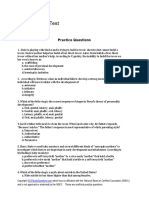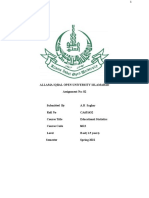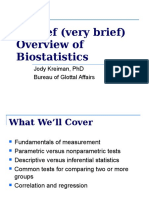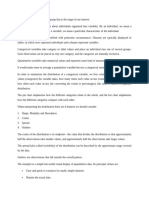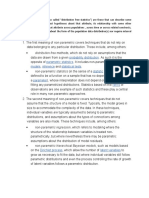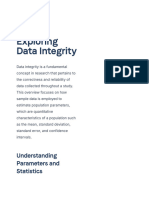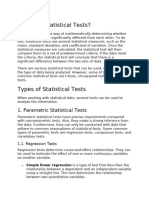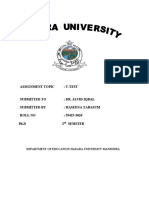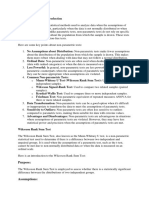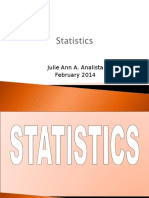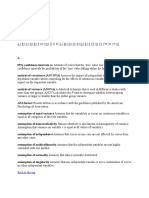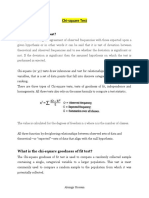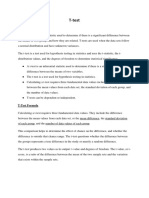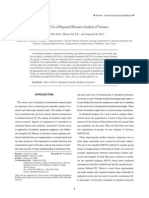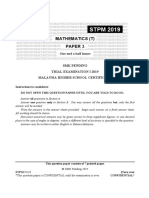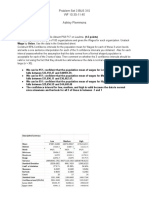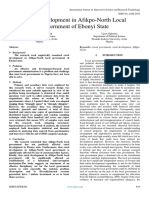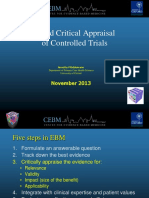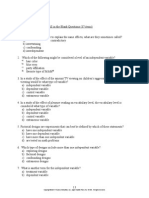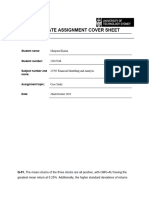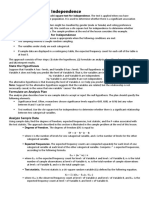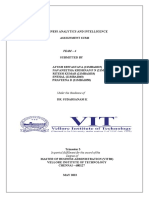Editorial How To Choose The Right Statistical Test?
Editorial How To Choose The Right Statistical Test?
Uploaded by
Mary PerlecheCopyright:
Available Formats
Editorial How To Choose The Right Statistical Test?
Editorial How To Choose The Right Statistical Test?
Uploaded by
Mary PerlecheOriginal Title
Copyright
Available Formats
Share this document
Did you find this document useful?
Is this content inappropriate?
Copyright:
Available Formats
Editorial How To Choose The Right Statistical Test?
Editorial How To Choose The Right Statistical Test?
Uploaded by
Mary PerlecheCopyright:
Available Formats
Editorial
Today statistics provides the basis for inference in most medical research. Yet, for want of exposure to statistical theory and
practice, it continues to be regarded as the Achilles heel by all concerned in the loop of research and publication the researchers
(authors), reviewers, editors and readers.
Most of us are familiar to some degree with descriptive statistical measures such as those of central tendency and those of
dispersion. However, we falter at inferential statistics. This need not be the case, particularly with the widespread availability of
powerful and at the same time user-friendly statistical sofware. As we have outlined below, a few fundamental considerations
will lead one to select the appropriate statistical test for hypothesis testing. However, it is important that the appropriate statistical
analysis is decided before starting the study, at the stage of planning itself, and the sample size chosen is optimum. These cannot
be decided arbitrarily afer the study is over and data have already been collected.
The great majority of studies can be tackled through a basket of some 30 tests from over a 100 that are in use. The test to
be used depends upon the type of the research question being asked. The other determining factors are the type of data being
analyzed and the number of groups or data sets involved in the study. The following schemes, based on fve generic research
questions, should help.
[1]
Question 1: Is there a diference between groups that are unpaired? Groups or data sets are regarded as unpaired if there is
no possibility of the values in one data set being related to or being infuenced by the values in the other data sets. Diferent tests
are required for quantitative or numerical data and qualitative or categorical data as shown in Fig. 1. For numerical data, it is
important to decide if they follow the parameters of the normal distribution curve (Gaussian curve), in which case parametric tests
are applied. If distribution of the data is not normal or if one is not sure about the distribution, it is safer to use non-parametric
tests. When comparing more than two sets of numerical data, a multiple group comparison test such as one-way analysis of
variance (ANOVA) or Kruskal-Wallis test should be used frst. If they return a statistically signifcant p value (usually meaning
p < 0.05) then only they should be followed by a post hoc test to determine between exactly which two data sets the diference
lies. Repeatedly applying the t test or its non-parametric counterpart, the Mann-Whitney U test, to a multiple group situation
increases the possibility of incorrectly rejecting the null hypothesis.
Question 2: Is there a diference between groups which are paired? Pairing signifes that data sets are derived by repeated
measurements (e.g. before-afer measurements or multiple measurements across time) on the same set of subjects. Pairing will
also occur if subject groups are diferent but values in one group are in some way linked or related to values in the other group
(e.g. twin studies, sibling studies, parent-ofspring studies). A crossover study design also calls for the application of paired
group tests for comparing the efects of diferent interventions on the same subjects. Sometimes subjects are deliberately paired
to match baseline characteristics such as age, sex, severity or duration of disease. A scheme similar to Fig. 1 is followed in paired
data set testing, as outlined in Fig. 2. Once again, multiple data set comparison should be done through appropriate multiple
group tests followed by post hoc tests.
Question 3: Is there any association between variables? The various tests applicable are outlined in Fig. 3. It should be noted
that the tests meant for numerical data are for testing the association between two variables. These are correlation tests and
How to choose the right statistical test?
Figure 1: Tests to address the question: Is there a difference between
groups unpaired (parallel and independent groups) situation?
Numerical data Categorical data
Parametric Otherwise 2 groups > 2 groups
2 groups
Unpaired
t test
> 2 groups
Analysis of
variance
(ANOVA)
or F test
2 groups
Mann-Whitney
U test
Wilcoxon's rank
sum test
> 2 groups
Kruskall-Wallis
H test (Kruskall-Wallis
ANOVA)
Chi-square
[
2
] test
Chi-square
[
2
] test
Fisher's
exact test
Post-hoc (multiple group comparison) tests are to be applied in the event that
ANOVA or its non-parametric counterpart shows a signifcant difference (to detect
between which two groups the signifcant difference lies). Examples of such tests are:
Parametric data: Tukeys Honestly Signifcant Difference test (Tukey-Kramer
test), Newman-Keuls test, Bonferronis test, Dunnetts test, Scheffes test, etc.
Non-parametric data: Dunns test.
Figure 2: Tests to address the question: Is there a difference between
groups paired situation?
Numerical data Categorical data
Parametric
Otherwise 2 groups > 2 groups
2 groups
Paired t test
> 2 groups
Repeated
measures
ANOVA
2 groups
Wilcoxon's
matched
pairs signed
rank test
> 2 groups
Friedman's ANOVA
McNemar's
test
Cochran's
Q test
McNemar's
test
exact variants
Post-hoc (multiple group comparison) tests to be applied in the event that
Repeated measures ANOVA or its non-parametric counterpart shows a signifcant
difference (to detect between which two data sets the signifcant difference lies)
include:
Parametric data: Wilcoxons matched pairs signed rank test.
Non-parametric data: Dunns test
[Downloadedfreefromhttp://www.ijo.inonTuesday,January15,2013,IP:190.42.243.139]||ClickheretodownloadfreeAndroidapplicationforthisjournal
86 IndianJournalofOphthalmology Vol. 59 No. 2
they express the strength of the association as a correlation
coefcient. An inverse correlation between two variables is
depicted by a minus sign. All correlation coefcients vary
in magnitude from 0 (no correlation at all) to 1 (perfect
correlation). A perfect correlation may indicate but does not
necessarily mean causality. When two numerical variables
are linearly related to each other, a linear regression analysis
can generate a mathematical equation, which can predict
the dependent variable based on a given value of the independent variable.
[2]
Odds ratios and relative risks are the staple of
epidemiologic studies and express the association between categorical data that can be summarized as a 2 2 contingency table.
Logistic regression is actually a multivariate analysis method that expresses the strength of the association between a binary
dependent variable and two or more independent variables as adjusted odds ratios.
Question 4: Is there agreement between data sets? This can be a comparison between a new screening technique against the
standard test, new diagnostic test against the available gold standard or agreement between the ratings or scores given by diferent
observers. As seen from Fig. 4, agreement between numerical variables may be expressed quantitatively by the intraclass correlation
coefcient or graphically by constructing a Bland-Altman plot in which the diference between two variables x and y is ploted
against the mean of x and y. In case of categorical data, the Cohens Kappa statistic is frequently used, with kappa (which varies
from 0 for no agreement at all to 1 for perfect agreement) indicating strong agreement when it is > 0.7. It is inappropriate to infer
agreement by showing that there is no statistically signifcant diference between means or by calculating a correlation coefcient.
Question 5: Is there a diference between time-to-event trends or survival plots? This question is specifc to survival analysis
[3]
(the endpoint for such analysis could be death or any event that can occur afer a period of time) which is characterized by
censoring of data, meaning that a sizeable proportion of the original study subjects may not reach the endpoint in question by
the time the study ends. Data sets for survival trends are always considered to be non-parametric. If there are two groups then
the applicable tests are Cox-Mantel test, Gehans (generalized Wilcoxon) test or log-rank test. In case of more than two groups
Peto and Petos test or log-rank test can be applied to look for signifcant diference between time-to-event trends.
It can be appreciated from the above outline that distinguishing between parametric and non-parametric data is important.
Tests of normality (e.g. Kolmogorov-Smirnov test or Shapiro-Wilk goodness of ft test) may be applied rather than making
assumptions. Some of the other prerequisites of parametric tests are that samples have the same variance i.e. drawn from the same
population, observations within a group are independent and that the samples have been drawn randomly from the population.
A one-tailed test calculates the possibility of deviation from the null hypothesis in a specifc direction, whereas a two-tailed
test calculates the possibility of deviation from the null hypothesis in either direction. When Intervention A is compared with
Intervention B in a clinical trail, the null hypothesis assumes there is no diference between the two interventions. Deviation
from this hypothesis can occur in favor of either intervention in a two-tailed test but in a one-tailed test it is presumed that only
one intervention can show superiority over the other. Although for a given data set, a one-tailed test will return a smaller p value
than a two-tailed test, the later is usually preferred unless there is a watertight case for one-tailed testing.
It is obvious that we cannot refer to all statistical tests in one editorial. However, the schemes outlined will cover the hypothesis
testing demands of the majority of observational as well as interventional studies. Finally one must remember that, there is no
substitute to actually working hands-on with dummy or real data sets, and to seek the advice of a statistician, in order to learn
the nuances of statistical hypothesis testing.
Barun K Nayak, Aviit Hazra
1
P. D. Hinduja National Hospital, Veer Savarkar Marg, Mumbai - 400 016,
1
Department of Pharmacololgy,
Institute of Postgraduate Medical Education & Research (IPGME&R), 244B Acharya J. C. Bose Road, Kolkata - 700020, India.
E-mail: io.editor@gmail.com
References
1. Hypothesis testing and choice of statistical tests. In: Parikh MN, Hazra A, Mukherjee J, Gogtay N, editors. Research methodology simplifed:
Every clinician a researcher. New Delhi: Jaypee Brothers; 2010. p. 121-8.
2. The theory of linear regression and performing a linear regression analysis. In: Petrie A, Sabin C, editors. Medical statistics at a glance. 2
nd
ed. London: Blackwell Publishing; 2005. p. 70-3.
3. Wang D, Clayton T, Bakhai A. Analysis of survival data. In: Wang D, Bakhai A, editors. Clinical trials: A practical guide to design, analysis
and reporting. London: Remedica; 2006. p. 235-52.
DOI: 10.4103/0301-4738.77005 PMID: ******
Figure 3: Tests to address the question: Is there an association
between variables?
Numerical data Categorical data
Both variables
parametric
Otherwise 2 X 2 data Otherwise
Pearson's
(product moment
correlation
coefficient) r
Spearman's
(rank correlation
coefficient)
Kendall's (rank
correlation
coefficient)
Relative risk
[Risk ratio]
Chi-square
test for trend
Logistic
regression
Odds ratio
Figure 4: Tests to address the question: Is there an agreement between
assessment (screening / rating / diagnostic) techniques?
Numerical data Categorical data
Intraclass correlation coefficient
(quantitative method) Bland-Altman
plot (graphical method)
Cohen's Kappa statistic
[Downloadedfreefromhttp://www.ijo.inonTuesday,January15,2013,IP:190.42.243.139]||ClickheretodownloadfreeAndroidapplicationforthisjournal
You might also like
- Assignment 2 Group 1 ReportDocument13 pagesAssignment 2 Group 1 Reportseksenbaeva.nurgulNo ratings yet
- Inferential StatisticsDocument48 pagesInferential StatisticsNylevon78% (9)
- Nce Practice Test PDFDocument58 pagesNce Practice Test PDFScribd100% (1)
- Presentation T TestDocument31 pagesPresentation T TestEe HAng Yong0% (1)
- CH 5 PDFDocument14 pagesCH 5 PDFHadhi Hassan Khan100% (1)
- DBA-5102 Statistics - For - Management AssignmentDocument12 pagesDBA-5102 Statistics - For - Management AssignmentPrasanth K SNo ratings yet
- How To Choose The Right Statistical TestDocument3 pagesHow To Choose The Right Statistical TesttanuaggarwalNo ratings yet
- Activity 5Document28 pagesActivity 5Hermis Ramil TabhebzNo ratings yet
- Unit 1Document9 pagesUnit 1Saral ManeNo ratings yet
- Unit-4 Hypothesis Testing F T Z Chi TestDocument17 pagesUnit-4 Hypothesis Testing F T Z Chi TestVipin SinghNo ratings yet
- STats - Descriptive and Inferential DivisionsDocument4 pagesSTats - Descriptive and Inferential DivisionsStudent-here14No ratings yet
- Allama Iqbal Open University Islamabad: Muhammad AshrafDocument25 pagesAllama Iqbal Open University Islamabad: Muhammad AshrafHafiz M MudassirNo ratings yet
- Inferential Statistics For Data ScienceDocument10 pagesInferential Statistics For Data Sciencersaranms100% (1)
- Saghar 8612-2Document22 pagesSaghar 8612-2Anila zafarNo ratings yet
- A Brief (Very Brief) Overview of Biostatistics: Jody Kreiman, PHD Bureau of Glottal AffairsDocument56 pagesA Brief (Very Brief) Overview of Biostatistics: Jody Kreiman, PHD Bureau of Glottal AffairsjamesteryNo ratings yet
- Module 4Document9 pagesModule 4Kwasi AppiahNo ratings yet
- What Is A Chi-Square Statistic?Document10 pagesWhat Is A Chi-Square Statistic?Pirate 001No ratings yet
- CHAPTER 7 - Research 10 1Document8 pagesCHAPTER 7 - Research 10 1hiroe sagaraNo ratings yet
- Distribution Free Methods, Which Do Not Rely On Assumptions That TheDocument4 pagesDistribution Free Methods, Which Do Not Rely On Assumptions That TheNihar JawadinNo ratings yet
- T TEST LectureDocument26 pagesT TEST LectureMax SantosNo ratings yet
- Maryangel Literature Review Assignment - 110449Document11 pagesMaryangel Literature Review Assignment - 110449akani brightNo ratings yet
- Statistical TestsDocument11 pagesStatistical Testsluzviminda.dulayNo ratings yet
- Data Collection: SamplingDocument8 pagesData Collection: SamplingskyNo ratings yet
- Unit 1Document9 pagesUnit 1Saral ManeNo ratings yet
- Testing The Difference - T Test ExplainedDocument17 pagesTesting The Difference - T Test ExplainedMary Mae PontillasNo ratings yet
- Bivariate AnalysisDocument16 pagesBivariate AnalysisDENNIS N. MUÑOZNo ratings yet
- VND - Openxmlformats Officedocument - Wordprocessingml.document&rendition 1Document4 pagesVND - Openxmlformats Officedocument - Wordprocessingml.document&rendition 1TUSHARNo ratings yet
- 5 How To Analyze Your Data: Nonparametric ParametricDocument18 pages5 How To Analyze Your Data: Nonparametric ParametricSubhankar SanyalNo ratings yet
- Analysis & Interpretation of DataDocument24 pagesAnalysis & Interpretation of DataMary Ann HabitanNo ratings yet
- Research Methods Unit 4Document6 pagesResearch Methods Unit 4MukulNo ratings yet
- Unit 545 Differences Between Two or More Groups Non Parametric With AnswersDocument10 pagesUnit 545 Differences Between Two or More Groups Non Parametric With Answersz13612909240No ratings yet
- Summary | Raena AIDocument12 pagesSummary | Raena AIArt ShannonNo ratings yet
- Most Frequently Used Terms in Biostatistics: Your LogoDocument44 pagesMost Frequently Used Terms in Biostatistics: Your LogocainbelzebubNo ratings yet
- Inbound 5551582874256769239Document5 pagesInbound 5551582874256769239demitherese0823No ratings yet
- Assignment Topic: T-Test: Department of Education Hazara University MansehraDocument5 pagesAssignment Topic: T-Test: Department of Education Hazara University MansehraEsha EshaNo ratings yet
- BRM Unit-3Document22 pagesBRM Unit-3K R SAI LAKSHMINo ratings yet
- Example 1ststDocument10 pagesExample 1ststRoidar khanNo ratings yet
- Notes Unit-4 BRMDocument10 pagesNotes Unit-4 BRMDr. Moiz AkhtarNo ratings yet
- U01d2 Questions About StatisticsDocument3 pagesU01d2 Questions About Statisticsarhodes777No ratings yet
- Julie Ann A. Analista February 2014Document67 pagesJulie Ann A. Analista February 2014Julie AnalistaNo ratings yet
- PSAI Unit 5Document25 pagesPSAI Unit 5vasikar22No ratings yet
- GlossaryDocument27 pagesGlossary29_ramesh170No ratings yet
- Continous Assessment Answer SheetDocument29 pagesContinous Assessment Answer Sheetmounika kNo ratings yet
- Chi-Square Test: What Do You Mean X Test?Document5 pagesChi-Square Test: What Do You Mean X Test?Alamgir HossainNo ratings yet
- Statistics For A2 BiologyDocument9 pagesStatistics For A2 BiologyFaridOraha100% (1)
- Differences and Similarities Between ParDocument6 pagesDifferences and Similarities Between ParPranay Pandey100% (1)
- Multivariate AnalysisDocument11 pagesMultivariate AnalysisCerlin PajilaNo ratings yet
- Hypothesis Testing Parametric and Non Parametric TestsDocument14 pagesHypothesis Testing Parametric and Non Parametric Testsreeya chhetriNo ratings yet
- SPSS AssignmentDocument6 pagesSPSS Assignmentaanya jainNo ratings yet
- Data Analysis LectureDocument17 pagesData Analysis LectureSamantha Vhiel VicenteNo ratings yet
- Correct Use of Repeated Measures Analysis of Variance: Eunsik Park, PH.D., Meehye Cho, B.SC., and Chang-Seok Ki, M.DDocument9 pagesCorrect Use of Repeated Measures Analysis of Variance: Eunsik Park, PH.D., Meehye Cho, B.SC., and Chang-Seok Ki, M.Dhubik38No ratings yet
- Chi Square TestDocument13 pagesChi Square Testjunielamores29No ratings yet
- Crosstabulation and Chi Square Analysis SummaryDocument8 pagesCrosstabulation and Chi Square Analysis SummaryViesturs AleksīnsNo ratings yet
- Research Methodology AssignmentDocument15 pagesResearch Methodology Assignmentpashasadiq4444No ratings yet
- Business Research CH-6Document28 pagesBusiness Research CH-6bereket.7fNo ratings yet
- Final ExamDocument5 pagesFinal ExamLosarim MalingNo ratings yet
- Student's T TestDocument56 pagesStudent's T TestmelprvnNo ratings yet
- Non Parametric TestDocument16 pagesNon Parametric TestVIKAS DOGRA100% (1)
- Statistical Tests For Comparative StudiesDocument7 pagesStatistical Tests For Comparative StudiesalohaNo ratings yet
- Screenshot 2024-03-09 at 21.19.03Document3 pagesScreenshot 2024-03-09 at 21.19.03adamhamida351No ratings yet
- Biostatistics NotesDocument6 pagesBiostatistics Notesdeepanjan sarkarNo ratings yet
- Taking 20the 20fear 20out 20of 20data 20 YsisDocument347 pagesTaking 20the 20fear 20out 20of 20data 20 Ysisws7ycw6hy2No ratings yet
- NameDocument2 pagesNameJosielyn Camara DistorNo ratings yet
- Research Designs Used in Quantitative Research: Descriptive Research Design Experimental Research DesignDocument55 pagesResearch Designs Used in Quantitative Research: Descriptive Research Design Experimental Research Designbona veronica viduyaNo ratings yet
- Impact of Social Media On Brand Loyalty Papr 16Document16 pagesImpact of Social Media On Brand Loyalty Papr 16Ahmed100% (1)
- The Power of A B Testing Marketo PDFDocument24 pagesThe Power of A B Testing Marketo PDFjhsal8444No ratings yet
- Analysis of Automobile Sales in Top 10 States of IndiaDocument26 pagesAnalysis of Automobile Sales in Top 10 States of IndiaAayush SinghNo ratings yet
- Clicks Vs Class: A Statistical Analysis of Social Media and Academic PerformanceDocument11 pagesClicks Vs Class: A Statistical Analysis of Social Media and Academic PerformanceismailkohitNo ratings yet
- Understanding The Two-Way ANOVADocument14 pagesUnderstanding The Two-Way ANOVAMaridil Joy IsidroNo ratings yet
- SMK Pending (Q)Document7 pagesSMK Pending (Q)Hui YiNo ratings yet
- PS 3 Bus 310 ResubmitDocument7 pagesPS 3 Bus 310 ResubmitAshley PlemmonsNo ratings yet
- Rural Development in Afikpo-North Local Government of Ebonyi StateDocument8 pagesRural Development in Afikpo-North Local Government of Ebonyi StateInternational Journal of Innovative Science and Research TechnologyNo ratings yet
- RM Unit3 SlidesDocument172 pagesRM Unit3 Slidesrheasudheer.19No ratings yet
- Rapid Critical Appraisal of Controlled Trials Annette PluddemannDocument48 pagesRapid Critical Appraisal of Controlled Trials Annette PluddemannRistyNo ratings yet
- A Comparative Analysis of Income and Expenditure Pattern of Working and Non-Working Women in TamilnaduDocument8 pagesA Comparative Analysis of Income and Expenditure Pattern of Working and Non-Working Women in TamilnaduiaetsdiaetsdNo ratings yet
- Statistics HandoutDocument15 pagesStatistics HandoutAnish GargNo ratings yet
- Salkind TB Ch02-8edDocument8 pagesSalkind TB Ch02-8edPrince QueenoNo ratings yet
- Swathi Final Project HinduDocument89 pagesSwathi Final Project HinduSwathi SwathiNo ratings yet
- Case Study 420Document4 pagesCase Study 420MONJURUL KARIMNo ratings yet
- Protein SupplementDocument93 pagesProtein Supplementdesaitejas100% (1)
- Introduction To Data AnalyticsDocument30 pagesIntroduction To Data AnalyticspreethiNo ratings yet
- The Influence of Employer Branding and Employee VaDocument15 pagesThe Influence of Employer Branding and Employee VaGovindu SNo ratings yet
- Chi Square TestDocument11 pagesChi Square Testmellite copperNo ratings yet
- Study of Financial Performance of Cement Industry by Using Du-Pont AnalysisDocument5 pagesStudy of Financial Performance of Cement Industry by Using Du-Pont AnalysisAhmad IbrarNo ratings yet
- Unit-5 BS& ADocument71 pagesUnit-5 BS& Aus825844No ratings yet
- ATG-MET11-L1-Correlation AnalysisDocument33 pagesATG-MET11-L1-Correlation AnalysisMeljoy TenorioNo ratings yet
- Business Analytics and Intelligence AssignmentDocument12 pagesBusiness Analytics and Intelligence AssignmentAyush SrivastavaNo ratings yet
- WK5 Assgn Yun DDocument4 pagesWK5 Assgn Yun DdorothyNo ratings yet
- Statistical HypothesisDocument70 pagesStatistical HypothesisJhoanie Marie CauanNo ratings yet


